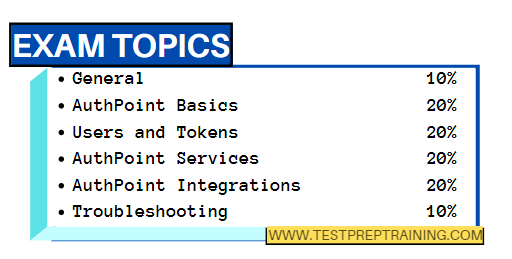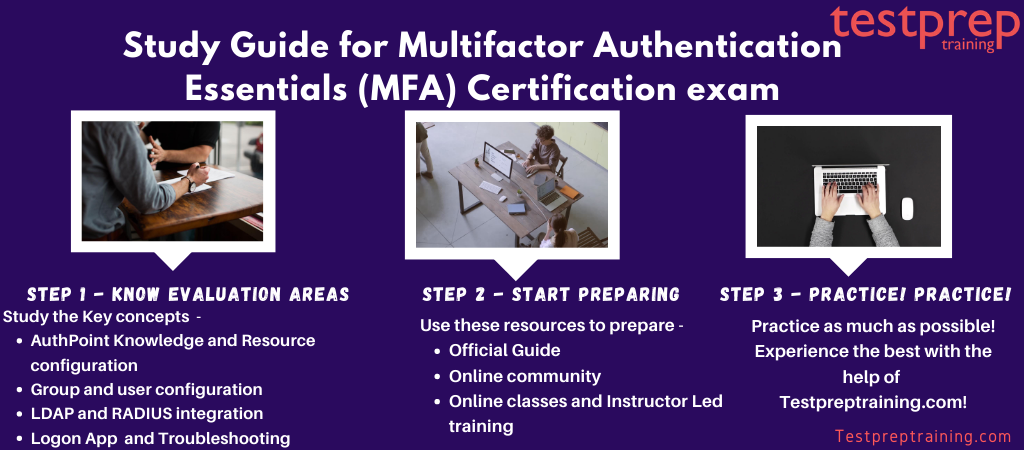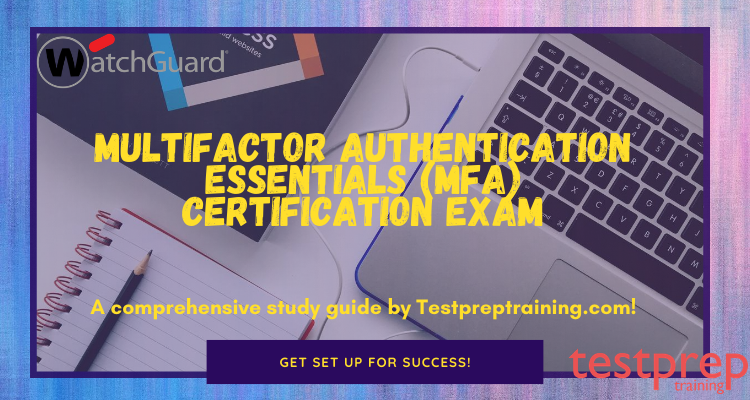The Multi-factor Authentication Essentials (MFA) exam is a certification offered by Salesforce that tests an individual’s knowledge and skills related to implementing and managing multi-factor authentication (MFA) in Salesforce environments.
Here are some key concepts and topics that are covered in the MFA exam:
- Multi-factor Authentication: The use of two or more factors to authenticate a user’s identity, such as a password and a one-time code sent to a mobile device.
- Identity and Access Management: The set of processes and technologies used to manage user identities and control access to resources.
- Authentication Methods: The various methods used to authenticate user identities, such as passwords, biometric data, and security tokens.
- Identity Providers: Services that provide user authentication and identity management services, such as Okta and Microsoft Azure Active Directory.
- Single Sign-On: A method of authentication that allows users to access multiple applications with a single set of credentials.
- Security Compliance: The set of regulations and standards that organizations must comply with to ensure the security and privacy of user data, such as GDPR and HIPAA.
- Risk Management: The process of identifying and mitigating potential security risks, such as phishing attacks and data breaches.
- Security Monitoring: The use of monitoring tools and techniques to detect and respond to security threats and incidents.
- Data Encryption: The process of converting data into a format that is unreadable without a decryption key, to protect it from unauthorized access.
- User Training and Awareness: The process of educating users on security best practices and raising awareness of security risks.
By understanding these concepts and topics, you can better prepare for the Multi-factor Authentication Essentials (MFA) exam and demonstrate your expertise in implementing and managing MFA in Salesforce environments.

Exam Overview
There will be 55 multiple choices (choose one option), multiple selections (pick more than one option), true/false, and matching questions starting with the Multi-Factor Authentication Essentials test questions. To pass the exam, you must get a score of 75 percent or above. The test has a time restriction of two hours to complete. This is a proctored exam with two testing locations: the Kryterion testing facility and online, with virtual proctoring through an authorized webcam.
The Multi-Factor Authentication video course or instructor-led course is recommended, but not required. The cost of taking the exam is 200 USD.
| Name of the exam | Multi-Factor Authentication Essentials exam |
| No. and type of questions | 55 multiple choice (select one option), multiple selection (select more than one option), true/false, and matching questions. |
| Passing marks | 75% |
| Time allowed | 2 hours (120 minutes) |
| Cost of taking the exam | 200 USD |
These were the details of the exam which are essential to be known before sitting for the exam. Let us have a deeper look at the areas on which exam will evaluate a candidate.
Multi-factor Authentication Essentials (MFA) Exam Glossary
here are some essential terms related to multi-factor authentication (MFA) along with their definitions:
- Authentication: The process of verifying the identity of a user or device.
- Factor: A specific method used to verify the identity of a user. There are three common factors:a. Something you know (e.g., password, PIN)b. Something you have (e.g., smartphone, token, smart card)c. Something you are (e.g., biometric data such as fingerprint or facial recognition)
- Multi-factor authentication (MFA): A security measure that requires two or more factors to authenticate a user’s identity.
- Two-factor authentication (2FA): A security measure that requires two factors to authenticate a user’s identity.
- Multi-step authentication: A security measure that requires multiple steps or factors to authenticate a user’s identity.
- Authentication token: A small device, often a key fob, that generates a unique code at regular intervals that is used as a second factor for authentication.
- One-time password (OTP): A unique password that is generated for a single use and typically expires after a short period of time.
- Biometric authentication: The use of biometric data (e.g., fingerprint, facial recognition) to verify a user’s identity.
- Risk-based authentication: A security measure that evaluates various factors such as the user’s behavior, device used, and location to determine the level of risk associated with a login attempt, and applies appropriate authentication measures accordingly.
- Passwordless authentication: A method of authentication that does not require a password. It can use other factors such as biometric data, tokens, or email or SMS verification instead.
Multi-factor Authentication Essentials (MFA) Exam Study Guide
There are a variety of resources available for studying for the Multi-factor Authentication Essentials (MFA) exam. Here are a few suggestions:
- Official Study Guide: The MFA exam has an official study guide published by the International Association of Computer Science and Information Technology (IACSIT). This guide covers the exam objectives in detail and provides sample questions and answers.
- Online courses: Many online courses offer MFA training and certification programs. Udemy, Coursera, and LinkedIn Learning are some of the popular platforms that offer these courses.
- Practice exams: There are many practice exams available online, which can help you to get familiar with the types of questions you may encounter on the MFA exam. Some examples include CertMaster Practice, Kaplan IT Training, and MeasureUp.
- Books: There are several books available on the topic of multi-factor authentication, including “Multi-Factor Authentication for Dummies” by Craig Burton and “Identity is the New Perimeter: Modern Identity and Access Management” by Paul Lanzi and Sean Deuby.
- Industry events and conferences: Attending industry events and conferences can help you stay up to date with the latest trends and best practices in multi-factor authentication. The RSA Conference, Gartner Identity and Access Management Summit, and Identiverse are some of the popular events in this space.
Remember to study the exam objectives and create a study plan that works for you. Good luck with your preparation for the MFA exam!
Multi-factor Authentication Essentials (MFA) Exam Tips and Tricks
Multi-factor authentication (MFA) is a security technique that requires users to provide multiple forms of authentication to verify their identities. Here are some tips and tricks for passing the Multi-factor Authentication Essentials (MFA) exam:
- Understand the basics: Make sure you have a clear understanding of the different types of authentication factors, including something you know (e.g. password), something you have (e.g. token), and something you are (e.g. biometric data).
- Know the benefits of MFA: Familiarize yourself with the benefits of MFA, including increased security, reduced risk of unauthorized access, and improved compliance with industry regulations.
- Learn about MFA implementations: Be aware of the different ways MFA can be implemented, such as through hardware tokens, software tokens, SMS-based authentication, or biometric authentication.
- Know the challenges: Understand the challenges associated with implementing MFA, such as cost, user adoption, and potential user inconvenience.
- Study the relevant standards and regulations: Learn about the relevant standards and regulations related to MFA, such as the National Institute of Standards and Technology (NIST) guidelines and the Payment Card Industry Data Security Standard (PCI DSS).
- Practice with sample questions: Look for sample exam questions and practice answering them. This will help you identify any areas where you may need to focus your studying.
- Stay up to date: Stay informed about the latest developments in MFA technology and best practices, as well as any changes to relevant regulations or standards.
By following these tips and tricks, you can increase your chances of passing the Multi-factor Authentication Essentials (MFA) exam and gaining a deeper understanding of MFA technology and implementation.
Assessment Areas
The following are the topics on which the exam will access candidate’s ability and knowledge for clearing the exam –
Course Outline for Multi-factor Authentication Essentials Certification Exam was updated in March, 2021.

Topic 1: General
In this the candidates will understand the basic multi-factor authentication concepts that are not unique to AuthPoint. The sections include:
- MFA basics (Watchguard Documentation: Quick Start — Set Up AuthPoint)
- Distinguished names (Watchguard Documentation: Configure Active Directory Authentication)
- Active Directory tools (Watchguard Documentation: Configure Active Directory Authentication)
- SAML roles (Watchguard Documentation: Configure SAML Single Sign-On)
Topic 2: AuthPoint Basics
This will help candidates to understand how to set up AuthPoint. This include sections:
- AuthPoint Gateway (Watchguard Documentation: About Gateways)
- Resources of AuthPoint (Watchguard Documentation: AuthPoint Deployment Guide, Configure MFA)
- AuthPoint authentication policies
Topic 3: Users and Tokens
This provides understanding of how to set up AuthPoint. The sections are:
- AuthPoint external identities
- LDAP synchronization
- LDAP user management
- Hardware tokens and token management
Topic 4: AuthPoint Services
It will help in learning and understanding how to set up AuthPoint. The section in this are:
- Logon App setup
- Logon app resources (Watchguard Documentation: Configure MFA for a Computer or Server)
- Logon app MFA options
- IdP portal resource configuration
- SAML and IdP portal integration
Prepare for the exam using the Multi-Factor Authentication Essentials Study Guide!
Topic 5: AuthPoint Integrations
This provides understanding and knowledge of configuring RADIUS and SAML authentication. It include:
- RADIUS communication
- RADIUS client resources
- Network location policy objects
- SAML resource configuration
- SAML applications
Topic 6: Troubleshooting
This provides methods to troubleshoot the AuthPoint. The sections in this include:
- User authentication (Watchguard Documentation: User Authentication, User Authentication Steps)
- LDAP synchronization (Watchguard Documentation: Sync Users from Active Directory or LDAP)
- AuthPoint Gateway (Watchguard Documentation: About Gateways)
- RADIUS client (Watchguard Documentation: Configure RADIUS Server Authentication, RADIUS Authentication)
So, now we have complete knowledge about exam details and syllabus details of the exam. let us now look at the study resources that might prove resourceful in cracking the exam.
Study Resources
There are several tools available to help you prepare for the WatchGuard Multi-Factor Authentication Essentials test. However, one must use extreme caution while selecting materials, since they will decide how well you pass the exam. Libraries, bookstores, and online groups are all good places to look for materials. Let’s have a look at some resources that can assist in achieving positive outcomes.

Resource – 1: Official Resources
The official materials recommended by the vendor are the most reliable options for preparation. WatchGuard recommends a number of official resources, including the AuthPoint Gateway, groups and users, and the AuthPoint Mobile App. The resources may be found on the official website or in the official study guide.
Resource – 2: Online resources – classes and instructor led training
Experts with in-depth expertise in the subject create online classes and training. They assist in the clarification of concepts and give a wealth of useful information. There are several reputable educational websites that offer high-quality information. Candidates will benefit from instructor-led training as they gain hands-on experience in the classroom. Partners can also take advantage of WatchGuard’s free VILT technology-based training programs.
End-users can do so by enrolling in a class through our network of WatchGuard Certified Training Partners (WCTPs). Using their login, partners may sign up for training. On the WatchGuard website, end-users may also see the current WCTP training program. You can also take the help of tutorials by testpreptraining.com which is a significant way of preparation.
Resource – 3: Online community
People with similar interests form an online community. So, don’t be afraid to ask your questions in the community, since there is no greater guide than a seasoned professional. You can also learn about other people’s experiences and strategies. You can also learn about new resources and pool resources according to your needs.
Resource – 4: Practice papers and test series
The practice exam and test series for Multi-Factor Authentication Essentials might be quite helpful in your preparation. They assist you in identifying your weak areas and assisting you in improving to a larger extent. You will learn about your weak and strong areas by using these tests to measure yourself. You can pinpoint your flaw and then prevent it in tests. You can try a free Multi-Factor Authentication Essentials practice exam test now! There are many reliable sites that provide you with quality content and reliable material.



